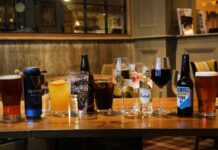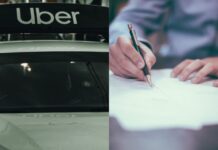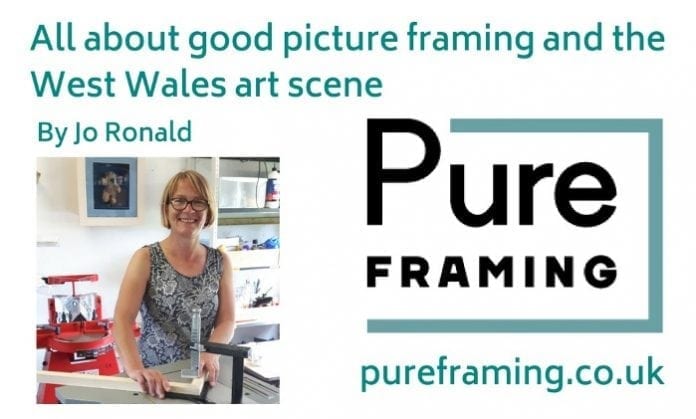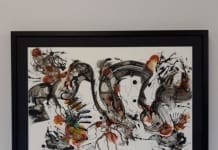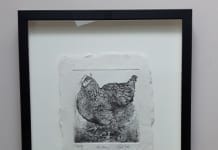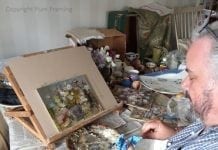Framing Knowhow
Last month I talked about the damage that can happen to a picture in a frame if the glass is touching the surface of the picture and simple ways to avoid this. Use of a window mount is one method.
The most commonly used form of window mount is a straightforward square or rectangular aperture cut into a mount board leaving a border on all four sides. The picture is displayed through this aperture.
If you are going to put a picture into a window mount yourself then there are a few basic rules that will give you good results, and a number of things you need to avoid to prevent problems in the future. All paper based artwork will expand and contract with changes in temperature and humidity, therefore the picture in the frame needs to be able to do this without restriction otherwise it will become distorted with a ripple effect (known in the trade as “cockling” and “buckling”).
The most common cause of distortion I come acrossis due to the picture being secured into the mount incorrectly. The basic rules are that the picture should never be secured to the window mount directly and it should only be secured along the top edge of the picture at two (or occasionally a few more) points – never with continuous strips of tape along any edge. I have come across all sorts: Pictures glued to the front mount; pictures taped on all four sides; pictures taped at the top only but with a continuous strip of tape along the top edge. These are all problems waiting to happen and once paper has distorted, it is almost impossible to flatten again.
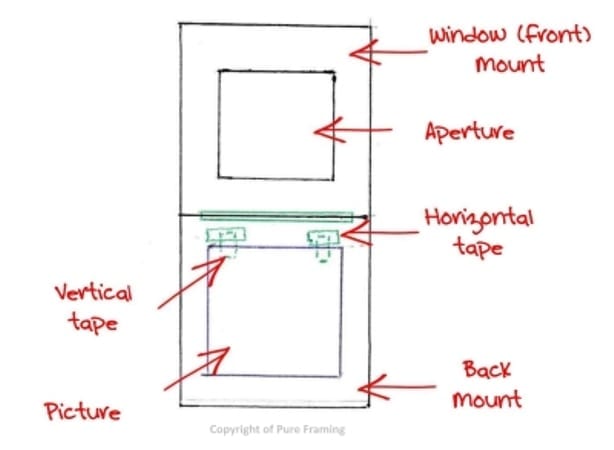 If you are going to mount a picture correctly yourself, you need to start with two pieces of mount board both cut to the correct size for the frame you are going to use. Cut the aperture into the “front mount” and then tape this to the uncut mount board (the “back mount”) along the long edge (top or left depending if it is landscape or portrait) so that it can open and close like a book. Your picture will be secured to the back mount, so firstly spend some time getting the picture into the correct position on the back mount to align it correctly in the front mount. Once you have the correct position, weight the picture down to prevent it from moving, then open the front mount up and lightly mark the position of the artwork onto the back mount using a pencil mark at each corner. Then remove the artwork, turn it over, and secure small vertical pieces of tape to the top edge (with as little as possible of one end of the tape stuck to the artwork – usually about 5mm will be sufficient unless it is particularly large or heavy). Two small pieces, close to either end (but not at the corners) are usually sufficient, but you may need a few more for larger or heavier pictures. Then turn the picture over again (image side up)with the tabs of tape visible above the picture, and place into position on the back mount within your pencil marks. Take more small pieces of tape and secure the picture to the back mount by sticking the tape horizontally across the vertical tabs showing above the picture (makes a “T” shape). Close the front mount down over the artwork and there you have it – a correctly mounted picture that will not distort in the mount as the paper expands and contracts.
If you are going to mount a picture correctly yourself, you need to start with two pieces of mount board both cut to the correct size for the frame you are going to use. Cut the aperture into the “front mount” and then tape this to the uncut mount board (the “back mount”) along the long edge (top or left depending if it is landscape or portrait) so that it can open and close like a book. Your picture will be secured to the back mount, so firstly spend some time getting the picture into the correct position on the back mount to align it correctly in the front mount. Once you have the correct position, weight the picture down to prevent it from moving, then open the front mount up and lightly mark the position of the artwork onto the back mount using a pencil mark at each corner. Then remove the artwork, turn it over, and secure small vertical pieces of tape to the top edge (with as little as possible of one end of the tape stuck to the artwork – usually about 5mm will be sufficient unless it is particularly large or heavy). Two small pieces, close to either end (but not at the corners) are usually sufficient, but you may need a few more for larger or heavier pictures. Then turn the picture over again (image side up)with the tabs of tape visible above the picture, and place into position on the back mount within your pencil marks. Take more small pieces of tape and secure the picture to the back mount by sticking the tape horizontally across the vertical tabs showing above the picture (makes a “T” shape). Close the front mount down over the artwork and there you have it – a correctly mounted picture that will not distort in the mount as the paper expands and contracts.
Next month I will talk to you about types of tape which are ok to use in framing. Some commonly available tapes are completely unsuitable and will cause problems.
If you want any advice or need some framing doing, please feel free to contact me – my details can be found on my website www.pureframing.co.uk
Local Art Scene
I recently spent a very enjoyable couple of hours with Tenby artist Guy Manning, chatting to him about his work at his Art Room on Upper Frog Street in the town. Guy has a real passion for the Pembrokeshire landscape. This is where he grew up and still lives with his wife Eloise Williams, an award winning author of children’s books.
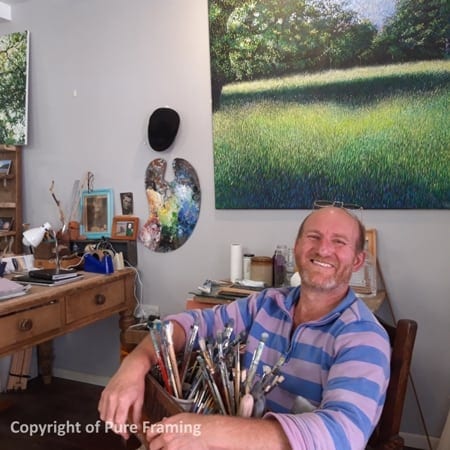 Guy spent his childhood and teens around Templeton and then some time away at college studying sculpture in Carmarthenand Derby. “Hiraeth” and a desire to concentrate on his sculptureprompted amove home to Pembrokeshire where herented a studio – a sail loft that he recalls was absolutely freezing in the winter. He spent his time sculpting and supplementing his income with part time farm labour and bar work. He then decided to study again and after qualifying to teach Art he spent a number of years doing this full-time and sculpting in his free time.
Guy spent his childhood and teens around Templeton and then some time away at college studying sculpture in Carmarthenand Derby. “Hiraeth” and a desire to concentrate on his sculptureprompted amove home to Pembrokeshire where herented a studio – a sail loft that he recalls was absolutely freezing in the winter. He spent his time sculpting and supplementing his income with part time farm labour and bar work. He then decided to study again and after qualifying to teach Art he spent a number of years doing this full-time and sculpting in his free time.
It was during this period that hefound that sculpture no longer meant as much to him as it had done and he came to the realisation that the Pembrokeshire landscape around him was his inspiration and he wanted to capture this. He started to experiment with painting –not a discipline he had worked in before. This is whereGuy’s story amazes me – he is a self-taught painter! I would never have guessed that from the wonderfulwork that he does. I asked him how on earth he had been able to make the transition so successfully without formal training. He explained that he already had drawing skills from his sculpture days and he enjoys studying the use and application of pigments and I have to say, he uses them to amazing effect. He even mixes his own base pigment using the red earth from one of the farms that he worked on in the early days. He had some fascinating stories about how some of the different pigments we are familiar with today came about. For instance, the reason we have Ultra Marine (blue) is because the price of Lapis Lazuli from Afghanistan (from which it was made) became prohibitively expensive for artists to use, so the French governmentset a challenge for scientists to come up with a synthetic alternative blue pigment that artists could use. A gentleman called Guimetcame up with the formula, was awarded the prize and synthetic Ultramarine was being produced in a factory by 1830.
I asked him how he came to open his own Art Room in Tenby. During his time teaching full time (Guy still teaches A Level Art part-time in Ceredigion) he had become what he called a “spare room painter”. He was showing and selling his work in other galleries, as well as teaching Art workshops privately in village halls and other rented spaces. Opening his own Art Room had been an ambition of his – somewhere he could work, display his art and teach courses all year round. The perfect opportunity came up when the shop he is now inbecame available. He took the plunge and “Guy Manning’s Art Room” opened last September. It is a lovely place to visit – you can see Guy’s work on display and for sale, you can see him at work, and if you would like to try your own hand at some painting, he runs regular small classes where he is on hand to help and guide you. He is very approachable and friendly and as it says on the sign “Kids, dogs and wellies welcome”. Why don’t you take a look next time you are in Tenby?
Art at the Hall Summer Exhibition “Surf, Sand and Sea” is coming …
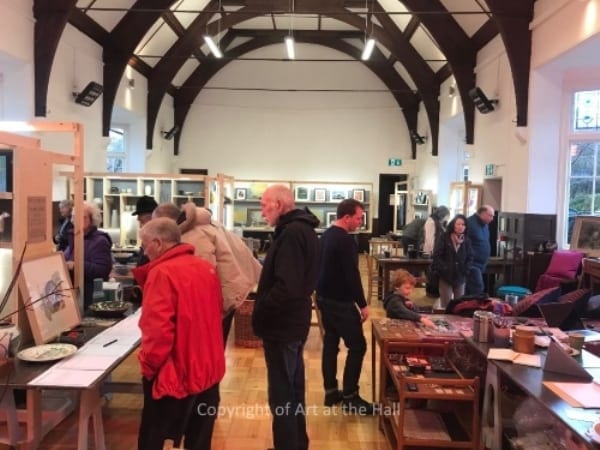 A fantastic opportunity to see and buy work by talented local artists and makers is coming soon at the summer show of Art at the Hall in Llangathen (just next door to Aberglasney Gardens). This is the second year that Art at the Hall has run its very successful pop-up exhibitions showcasing the best of local artistic talent. This exhibition will include not only regular exhibitors such as Andrew Douglas-Forbes and wildlife and landscape artist David Cowdry, but newcomers including renowned Llandeilo sculptor Gill Still and Swansea illustrator Hannah Davies. You will also be able to see the winning entries of the competition that I mentioned in last month’s column “Surf, Sand and Sea – Seascapes, Boats, Marine Wildlife, Waves …”. These winners will have had their work professionally framed by me for the show as Pure Framing is sponsoring this part of the prize.
A fantastic opportunity to see and buy work by talented local artists and makers is coming soon at the summer show of Art at the Hall in Llangathen (just next door to Aberglasney Gardens). This is the second year that Art at the Hall has run its very successful pop-up exhibitions showcasing the best of local artistic talent. This exhibition will include not only regular exhibitors such as Andrew Douglas-Forbes and wildlife and landscape artist David Cowdry, but newcomers including renowned Llandeilo sculptor Gill Still and Swansea illustrator Hannah Davies. You will also be able to see the winning entries of the competition that I mentioned in last month’s column “Surf, Sand and Sea – Seascapes, Boats, Marine Wildlife, Waves …”. These winners will have had their work professionally framed by me for the show as Pure Framing is sponsoring this part of the prize.
The Art at the Hall Summer Exhibition will be open to the public for two weeks from Saturday 25th August to Sunday 8th September.
Help keep news FREE for our readers
Supporting your local community newspaper/online news outlet is crucial now more than ever. If you believe in independent journalism, then consider making a valuable contribution by making a one-time or monthly donation. We operate in rural areas where providing unbiased news can be challenging. Read More About Supporting The West Wales Chronicle










